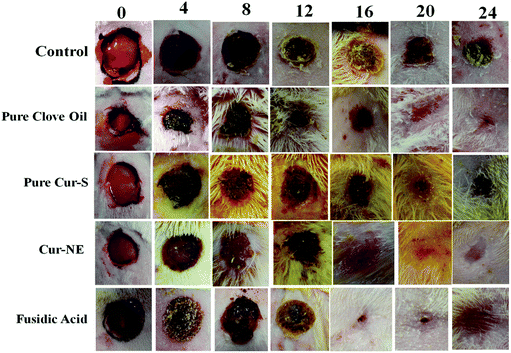 Open Access Article
Open Access ArticleCreative Commons Attribution 3.0 Unported Licence
Correction: Preparation of a novel curcumin nanoemulsion by ultrasonication and its comparative effects in wound healing and the treatment of inflammation
Niyaz Ahmad*ab,
Rizwan Ahmadc,
Ali Al-Qudaihia,
Salman Edrees Alaseela,
Ibrahim Zuhair Fitaa,
Mohammed Saifuddin Khalidd and
Faheem Hyder Pottood
aDepartment of Pharmaceutics, College of Clinical Pharmacy, Imam Abdulrahman Bin Faisal University, P. O. Box 1982, Dammam, Kingdom of Saudi Arabia-31441. E-mail: nanhussain@iau.edu.sa; niyazpharma@gmail.com; Fax: +966 13 333 0290; Tel: +966 13 333 5541, +966 53 120 3626
bDepartment of Pharmaceutical Chemistry, College of Clinical Pharmacy, Imam Abdulrahman Bin Faisal University, Dammam, Kingdom of Saudi Arabia
cDepartment of Natural Products and Alternative Medicine, College of Clinical Pharmacy, Imam Abdulrahman Bin Faisal University, Dammam, Kingdom of Saudi Arabia
dDepartment of Pharmacology, College of Clinical Pharmacy, Imam Abdulrahman Bin Faisal University, Dammam, Kingdom of Saudi Arabia
First published on 22nd July 2020
Abstract
Correction for ‘Preparation of a novel curcumin nanoemulsion by ultrasonication and its comparative effects in wound healing and the treatment of inflammation’ by Niyaz Ahmad et al., RSC Adv., 2019, 9, 20192–20206, DOI: 10.1039/C9RA03102B.
The authors regret errors in Fig. 7 in the original article. The corrected Fig. 7 is shown below where the panels at 8 and 12 days for fusidic acid and 16 and 20 days for Cur-NE have been replaced.
The Royal Society of Chemistry apologises for these errors and any consequent inconvenience to authors and readers.
| This journal is © The Royal Society of Chemistry 2020 |

